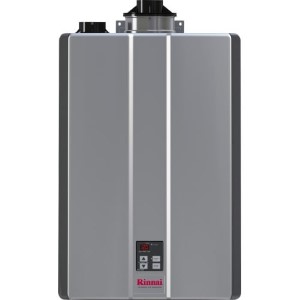- Home
- Gas Water Heaters
- Installation Checkllist
Installation Checklist for Gas Water Heaters
In this comprehensive guide, you'll uncover a detailed installation checklist for gas tank-type water heaters that employ atmospheric venting-a system designed to safely expel combustion products.
This primer will guide you through critical aspects such as site selection, the complexity of venting, plumbing requirements, electrical connections, and gas line considerations.
Beyond serving as a mere checklist, this guide aims to empower homeowners, installers, and professionals alike with the knowledge and insights needed to ensure a seamless and safe installation process.
By understanding the why's and how's of each step, you're not just following instructions; you're equipped to make informed decisions that affect the efficiency, safety, and longevity of your water heating system.
 Rheem
RheemEssential installation considerations
Before delving into the specifics of quality installation, it's essential to establish the foundation for a successful installation of gas tank-type water heaters.
The process is not just about placing a unit and connecting pipes; it’s about understanding the environment the heater will operate in, the safety protocols that need to be in place, and the performance efficiency you aim to achieve.
This section aims to provide you with a foundational understanding of the key elements that contribute to the optimal setup of your water heating system.
By prioritizing these considerations, you ensure not only the proper functioning of your water heater but also its compliance with safety standards, its adaptability to your living space, and its efficiency in delivering hot water when and where it's needed.
Let's explore the critical factors that underpin the successful installation of your gas water heater.
Location
- Optimal placement is crucial. The water heater should be situated as close as possible to the main hot water usage points, gas supply lines, vent discharge systems, and accessible power sources.
- Installation is mandated indoors with a direct route to expel combustion products outdoors.
- The unit must be positioned upright on a flat, stable surface that is not carpeted. Installations in bathrooms, bedrooms, or any regularly occupied spaces are strictly prohibited.
- A metallic drain pan placed under the unit can prevent water damage from leaks.
- Ensure the environment is safeguarded against freezing conditions to protect both the water heater and its plumbing.
- Maintain a safe distance from flammable materials such as fabrics, papers, and volatile substances to prevent fire hazards.
- The chosen area must be kept clean, devoid of dust, lint, and free from exposure to chemicals or fumes that could affect combustion.
- Accessibility for regular maintenance and emergency servicing should be prioritized.
- Water heaters damaged by flooding should not be operated under any circumstances.
- Installation in mobile homes requires models specifically approved for such use.
Venting
- The venting system must guide combustion gases outdoors efficiently.
- Placement should favor proximity to an existing chimney or venting outlet.
- All venting components should comply with local regulations and manufacturer's specifications regarding size and material.
- The draft hood and vent connectors need secure attachment to ensure safe exhaust flow.
- The flue and vent pipes should remain clear, maintaining consistent diameter without obstructions or damage.
- Venting design should minimize bends and length to optimize efficiency.
- Air intake provisions must be adequate to support combustion, with special considerations for installations in confined spaces. Small enclosures and confined areas must have two permanent openings. The size of each opening depends on the total BTUH input.
- Fresh air for combustion should not be sourced from areas with negative pressure or corrosive atmospheres.
Plumbing work
- Suitable materials such as CPVC or copper should be used for potable water connections.
- The Temperature and Pressure Relief (TPR) valve, a critical safety feature, must be correctly installed with an appropriate discharge line.
- Periodically test the TPR valve to ensure it operates correctly, releasing pressure as needed.
- Ensure all plumbing connections are leak-free.
- A shut-off valve on the cold water inlet allows for easy maintenance and emergencies.
- Closed systems require a thermal expansion tank to accommodate pressure fluctuations.
- Installation of mixing valves or anti-scald devices is recommended to mitigate the risk of excessively hot water.
- Utilize dielectric unions when connecting dissimilar metals to prevent galvanic corrosion.
- Insulate hot water pipes to minimize heat loss and improve energy efficiency.
Gas connections
- The gas supply line must include a shut-off valve, a ground joint union for easy disconnection, and a drip leg to catch moisture and debris.
- Adhere strictly to the specifications for pipe size and material as dictated by local codes and manufacturer guidelines.
- The water heater should only use the type of gas indicated on its rating plate.
- Conduct thorough inspections for gas leaks, rectifying any issues promptly.
- Ensure proper ventilation around the gas meter and connections to prevent gas buildup.
- Regularly check the integrity of the gas line fittings to maintain a secure and leak-free system.
- Keep the area around the water heater clear of flammable materials to reduce the risk of ignition.
Electrical work
- All electrical connections should be made in accordance with local codes and the manufacturer's detailed instructions.
- For optimal operation, ensure the water heater is installed near a 120 VAC power source.
- Limit the need for extensive wiring or alterations, simplifying installation.
- Use the properly rated circuit breakers and wiring to prevent overheating and fire risks.
- Grounding and bonding are critical for preventing electric shock.
- An inspection by a qualified electrician may be required for code compliance.
- Documentation of the installation process is essential for warranty claims and reference.
Related
- Home
- Gas Water Heaters
- Installation Checkllist



